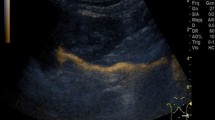Abstract
Background
The indirect radionuclide cystogram (IRC) has generally been reported as being less sensitive for detecting vesico-ureteric reflux (VUR) than the micturating cystourethrogram (MCUG), so we modified it in an attempt to increase its sensitivity.
Methods
We altered our routine IRC protocol by including the data obtained during failed voids, adding extra imaging sequences at intervals during bladder filling, and by using simple mathematical criteria to determine if VUR was present when visual imaging results were equivocal. We then retrospectively compared the VUR detection rates using the standard and modified techniques.
Results
We assessed 707 renal units in 356 children over 3 years. We identified 91 cases of VUR using standard methodology, and 134 (47 % more) with the modified technique. Of the extra 43 cases detected, 11 were noted during failed voids, ten were seen within a filling sequence, and 22 were inferred because the renal pelvic activity increased during an interval between two imaging sequences, while the bladder was filling. Mathematical evaluation was helpful in the 39 cases where the increase in activity due to VUR was ≤6 standard deviations greater than the level of background variation in activity.
Conclusions
Additional imaging and mathematical assessment can significantly increase the sensitivity of the IRC for detecting VUR, possibly to equal that of the MCUG.


Similar content being viewed by others
References
Mandell GA, Eggli DF, Gilday DL, Heyman S, Leonard JC, Miller JH, Nadel HR, Treves ST (1997) Procedure guideline for radionuclide cystography in children. J Nucl Med 38:1650–1654
Gordon I, Colarinha P, Fettich JJ, Fischer S, Frökier J, Hahn K, Kabasakal L, Mitjavila M, Olivier P, Piepsz A, Porn U, Sixt R, van Velzen J (2001) Guidelines for indirect radionuclide cystography. Eur J Nucl Med 28:BP16–BP20
Keir MJ, Coulthard MG, Lee REJ (1998) Radionuclide cystography revisited. Nucl Med Commun 19:1106
Gordon I, Peters A, Morony S (1990) Indirect radionuclide cystography: a sensitive technique for the detection of vesico-ureteral reflux. Pediatr Nephrol 4:604–606
Ključevšek D, Ključevšek T, Kersnik Levart T, Novljan G, Kenda RB (2010) Catheter-free methods for vesicoureteric reflux detection: our experience and a critical appraisal of existing data. Pediatr Nephrol 25:1201–1206
Stefanidis CJ, Siomou E (2007) Imaging strategies for vesicoureteral reflux diagnosis. Pediatr Nephrol 22:937–947
Author information
Authors and Affiliations
Corresponding author
Rights and permissions
About this article
Cite this article
Keir, M.J., Lambert, H.J. & Coulthard, M.G. Maximizing the sensitivity of the indirect radionuclide cystogram: a retrospective audit. Pediatr Nephrol 28, 2137–2141 (2013). https://doi.org/10.1007/s00467-013-2528-2
Received:
Revised:
Accepted:
Published:
Issue Date:
DOI: https://doi.org/10.1007/s00467-013-2528-2




